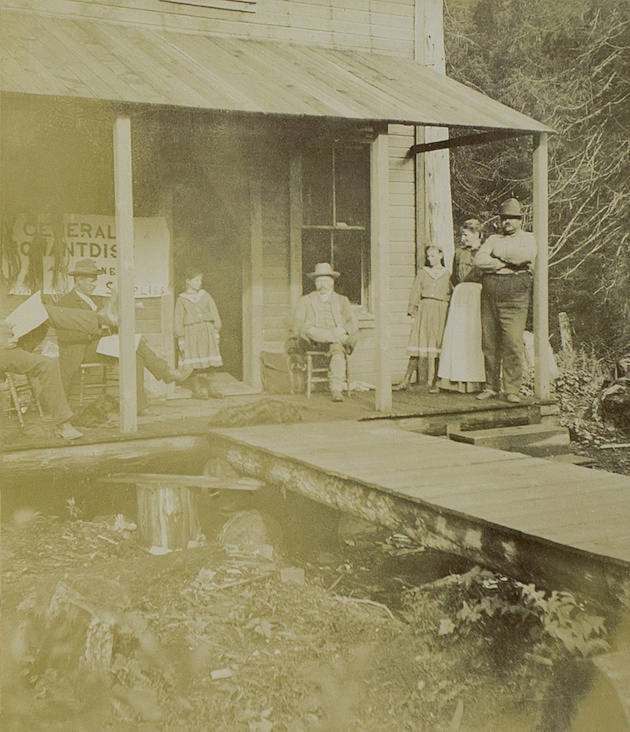One-hundred fifty-fourth in an alphabetical series on West Kootenay/Boundary place names
Porto Rico is an anglicized spelling of Puerto Rico. It was also the name of a mine at the head of Barrett Creek north of Ymir, a railway siding at the creek’s mouth, the mountain on which the claim was found, and a lumber company.
Which came first?
The mining claim, it appears, first mentioned in the Nelson Miner of Dec. 12, 1896 when a notice of bond was issued. Who staked it and why they chose that name is unknown, but the Minister of Mines report for 1897 stated: “The Canadian Pacific Exploration Co. Ltd., Eng., is opening up this property on the North Fork of Salmon River. A road seven miles long has been built from the [Nelson and Fort Sheppard Railway], and three tunnels on the vein, now aggregate 700 feet of work.”
The mine closed in 1899 but reopened and was worked until 1909.
 The earliest reference to the siding is in the Nelson Economist on June 1, 1898: “Porto Rico siding will be a busy point this summer, as considerable development will be done in that neighborhood.”
The earliest reference to the siding is in the Nelson Economist on June 1, 1898: “Porto Rico siding will be a busy point this summer, as considerable development will be done in that neighborhood.”
The mountain was first mentioned in the Miner of Nov. 5, 1898: “The Porto Rico group of six claims, situated on Porto Rico mountain six miles west of the siding of that name on the Nelson and Fort Sheppard railway in the Ymir district is being steadily developed.” (Today it’s known as Midday Peak.)
The Porto Rico Lumber Co. first appears in the Nelson Tribune of March 9, 1900 in an ad that noted it was the “successor to J.A. Dewar & Co.” The company had a mill at Porto Rico, but moved to Ymir in 1902. They also had a mill in Moyie and a sash and door factory in Moose Jaw.
The Beaver Lumber Co. of Winnipeg bought the company in late 1906 but kept the old name, which survived at least until 1914. They built another mill on the CPR flats in Nelson.
According to Jon Kalmakoff of the Doukhobor Genealogy Website, the Christian Community of Universal Brotherhood bought over 3,800 acres of timber in 1917 and operated a planer mail at Porto Rico under the name Salmon Valley Lumber and Pole Co.
A Porto Rico post office existed from 1918 until 1926, when a series of devastating forest fires dealt a fatal blow to the local lumber industry. In 1929, Porto Rico became an interment camp for over 200 Sons of Freedom exiled from Thrums, Brillliant, and Glade. You can learn more about this story at doukhobor.org/Porto-Rico.html.
The railway siding was abandoned in the 1930s, but a small community remained.
Porto Rico is remembered today in Porto Rico Rd. and Porto Rico-Ymir Rd. There is also a Porto Rico Rd. outside Moyie. Last year, UBC digitized two incredibly rare photos of the Porto Rico Hotel, ca. 1898 in the Uno Langmann collection.
Barrett Creek was sometimes called Porto Rico Creek in the 1940s and ‘50s, but it was never an official name.
Pottersville
In It’s A Wonderful Life, Pottersville is the vice-ridden version of Bedford Falls, New York that would have occurred had George Bailey never been born. Pottersville was also the name of an obscure townsite near Sandon.
The Ledge of May 13, 1897 noted: “Hamilton & McMillan have recently secured from G.D. Potter a group of three claims on the north fork of Carpenter creek. … A year’s supplies are now on the ground and a party of men are engaged running a crosscut on the Alps claim.”
The Sandon Paystreak of May 22 then reported: “The firm of Hamilton, McMillan and Co., for whom John Potter is manager, shows lots of enterprise and great confidence in the future of the camp … Pottersville, this fall, will be an assured fact and next summer a lively camp.”
The same paper added on June 19: “The survey of the townsite of Pottersville has been finished, also the wagon road from Three Forks up the north fork of Carpenter to the town, about four miles.”
Pottersville was never mentioned again. The townsite map is not known to survive.
John Potter (1852-fl. 1918) lived in Three Forks and Silverton and owned numerous mining claims in the area. It’s not clear how he was related to the aforementioned George D. Potter (1865-1911), who sold claims to Hamilton and McMillan and owned a sampling works in Wallace, Idaho. George had a brother named John, but it wasn’t the same guy.
— With thanks to Jon Kalmakoff
Previous installments in this series
Applegrove, Appleby, and Appledale revisited
Bakers, Birds, and Bosun Landing
Bannock City, Basin City, and Bear Lake City
Bealby Point (aka Florence Park) revisited
Boswell, Bosworth, Boulder Mill, and Broadwater
Brooklyn, Brouse, and Burnt Flat
Camborne, Cariboo City, and Carrolls Landing
Carmi, Cedar Point, Circle City, and Clark’s Camp
Carson, Carstens, and Cascade City
Christina City and Christian Valley
Cody and Champion Creek revisited
Champion Creek revisited, again
Columbia City, Columbia Gardens, and Columbia Park
Crawford Bay and Comaplix revisited
Dawson, Deadwood, and Deanshaven
English Cove and English Point
Forslund, Fosthall, and Fairview
Fort Shepherd vs. Fort Sheppard, Part 1
Fort Shepherd vs. Fort Sheppard, Part 2
Gladstone and Gerrard, revisited
Hall Siding and Healy’s Landing
Hudu Valley, Huntingtdon, and Healy’s Landing revisited
Inonoaklin Valley (aka Fire Valley)
Jersey, Johnsons Landing, and Jubilee Point
Kootenay Bay, Kraft, and Krestova
Kuskonook (and Kuskanax), Part 3
Labarthe, Lafferty, and Longbeach
Makinsons Landing and Marblehead
McDonalds Landing, McGuigan, and Meadow Creek
Meadows, Melville, and Miles’ Ferry
Mirror Lake and Molly Gibson Landing
Montgomery and Monte Carlo, Part 1
